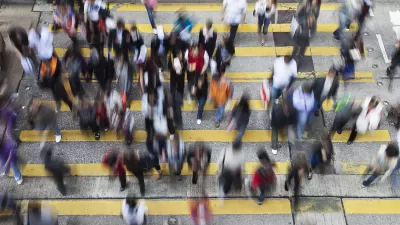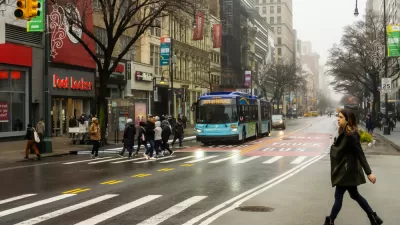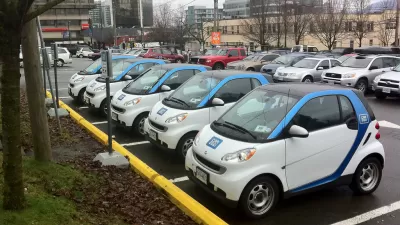A new Transit Center report shows what it takes to enact change.

According to the report, "A People’s History of Recent Urban Transportation Innovation," six cities stand out as innovators in the movement to redesign city streets for people, not cars: New York City, Portland, Chicago, Pittsburgh, Denver, and Charlotte. After half a century of building a national transportation infrastructure almost exclusively focused on accommodating automobiles, over the past decade cities across the country have shifted course, redesigning streets and public spaces for pedestrians and cyclists.
"While this may not seem 'innovative' in the technological sense, that cities would introduce bike lane networks, public plazas, mini-parks, and bikeshare wholesale onto American streets was inconceivable as recently as 2005," the report states.
How did they do it? Sandy Smith describes a three-tiered structure of roles, with citizens at the top. Citizen groups and local planning groups draw up the plans, raise public awareness and elect politicians. The relationship between the mayor’s office and constituents is critical. "By offering candidates energized blocs of voters, the advocates give politicians an opportunity to incorporate innovative thinking on urban mobility into their larger policy agendas," Smith writes.
Smith points out that the local bureaucrats tasked with implementing policies are stakeholders as well. Further, these are the people with the knowledge and savvy to design practical solution models for other cities to emulate. National movements such as the Vision Zero Network will rely on the expertise gained by local civil servants and devise broader strategies based on their successes and failures.
FULL STORY: Tracing the Urban Transportation Revolution

Planetizen Federal Action Tracker
A weekly monitor of how Trump’s orders and actions are impacting planners and planning in America.

Congressman Proposes Bill to Rename DC Metro “Trump Train”
The Make Autorail Great Again Act would withhold federal funding to the system until the Washington Metropolitan Area Transit Authority (WMATA), rebrands as the Washington Metropolitan Authority for Greater Access (WMAGA).

The Simple Legislative Tool Transforming Vacant Downtowns
In California, Michigan and Georgia, an easy win is bringing dollars — and delight — back to city centers.

The States Losing Rural Delivery Rooms at an Alarming Pace
In some states, as few as 9% of rural hospitals still deliver babies. As a result, rising pre-term births, no adequate pre-term care and "harrowing" close calls are a growing reality.

The Small South Asian Republic Going all in on EVs
Thanks to one simple policy change less than five years ago, 65% of new cars in this Himalayan country are now electric.

DC Backpedals on Bike Lane Protection, Swaps Barriers for Paint
Citing aesthetic concerns, the city is removing the concrete barriers and flexposts that once separated Arizona Avenue cyclists from motor vehicles.
Urban Design for Planners 1: Software Tools
This six-course series explores essential urban design concepts using open source software and equips planners with the tools they need to participate fully in the urban design process.
Planning for Universal Design
Learn the tools for implementing Universal Design in planning regulations.
Smith Gee Studio
City of Charlotte
City of Camden Redevelopment Agency
City of Astoria
Transportation Research & Education Center (TREC) at Portland State University
US High Speed Rail Association
City of Camden Redevelopment Agency
Municipality of Princeton (NJ)




























